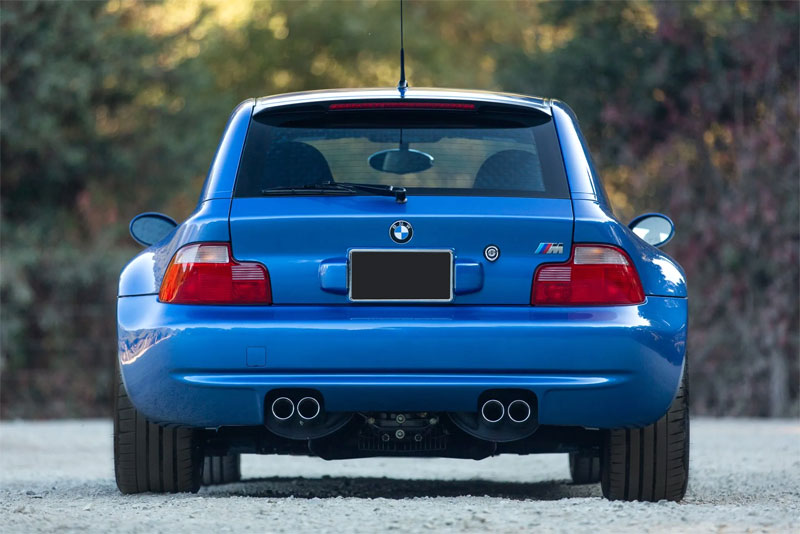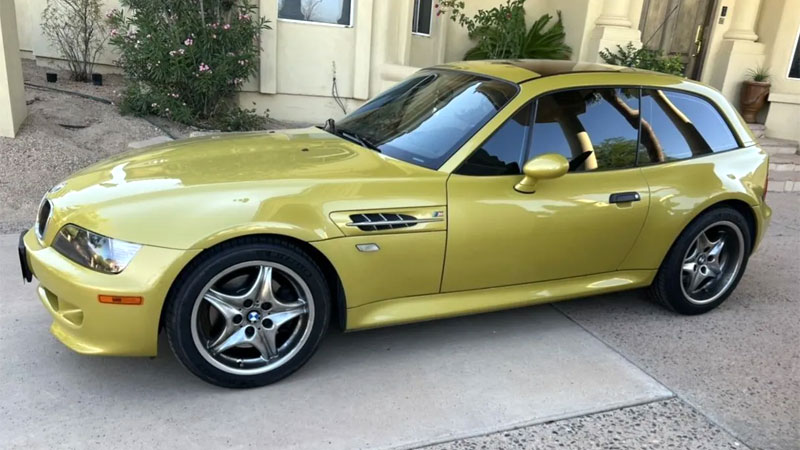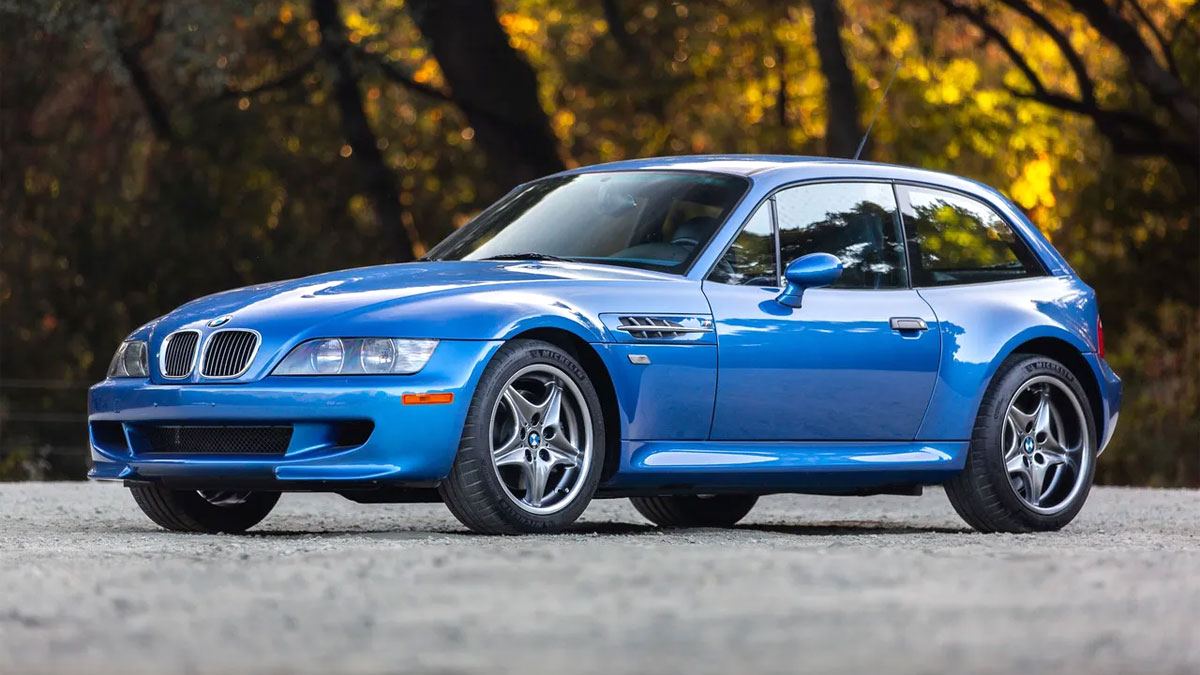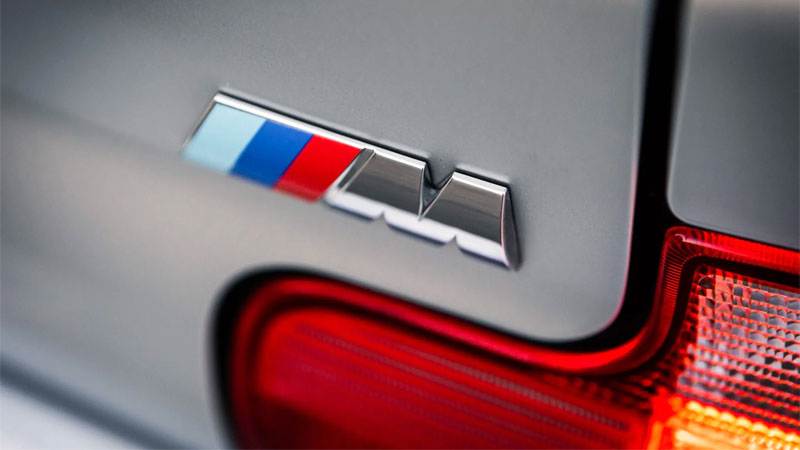In the late 1990s, BMW’s M division, known for creating high-performance versions of the brand’s vehicles, started a project that would ultimately result in one of the most unique sports cars of its time: the BMW M Coupe.
Born from the desire to combine the agility of a roadster with the practicality and rigidity of a coupe, the M Coupe quickly became a cult classic among automotive enthusiasts.
The M Coupe’s unique appearance, that quickly earned the nickname “clown shoe” due to its unconventional shape, showed its exceptional performance capabilities. Powered by a potent inline-six engine and boasting a perfect 50/50 weight distribution, the M Coupe offered an exhilarating driving experience on those who had the opportunity to get behind the wheel.
Read on to learn more about the history of the BMW M Coupe.
- Known for: Iconic shooting brake design (aka: clown shoe) that was quirky yet powerful.
- First Model Year: 1999
- Final Model Year: 2002
- Original Price in 1999: $41,800 (around $78k USD today)
- Total Sold in the US: 2,858 [source]
See Also – BMW Z8 History
Why Is It Called the “M Coupe”?
The BMW M Coupe’s name is a fusion of two key elements: the “M” signifies its high-performance pedigree, courtesy of BMW’s prestigious Motorsport division, while “Coupe” hints at its unique body style.
Despite its unconventional shooting brake design, which blends elements of a coupe and a hatchback, BMW chose to emphasize the car’s sporty intentions and spiritual connection to other M-badged two-door models.
The M Coupe’s distinctive appearance, characterized by a long hood, sloping roofline, and a practical hatchback rear end, sets it apart from traditional coupes. Yet, the name firmly establishes its place within the BMW family as a performance-oriented machine.
Development and Design
The BMW M Coupe’s journey from concept to reality began as a secret project (according to those in the know), spearheaded by a group of enthusiastic engineers within BMW’s M division.
These engineers, led by Burkhard Göschel, had a vision for a high-performance coupe that would combine the agility of the Z3 roadster with the practicality of a hatchback.
However, convincing BMW’s board to greenlight the project was no easy feat. The M Coupe’s unconventional design and niche appeal made it a risky proposition from a financial standpoint. Undeterred, the engineers pressed on, determined to bring their vision to life.
To keep costs down and ensure the project’s viability, the team had to be creative. They utilized as many existing components as possible, sharing parts with the Z3 roadster and other BMW models. The M Coupe’s front end, doors, and interior were largely borrowed from the Z3, while the rear end was a unique design that accommodated the hatchback layout.
The car’s distinctive silhouette, which earned it the nickname “clown shoe,” was a result of the engineers’ focus on functionality over convention.
The long hood, short rear deck, and tall, curved roofline provided ample cargo space without compromising the car’s sporting intentions. It was a design that prioritized substance over style, a testament to the M division’s performance-driven mindset.
Despite the challenges faced during development, the M Coupe’s design managed to capture the attention of car enthusiasts worldwide. Its quirky, purposeful appearance set it apart from other sports cars of the era, and its shooting brake-like layout offered a level of practicality not often found in high-performance vehicles.
Read Also – 2022 BMW M4 Competition Review
BMW M Coupe Generations
Throughout its brief but memorable production run, the BMW M Coupe underwent a significant evolution, with two distinct generations that showcased the car’s performance potential.
Each generation was defined by the engine that powered it, with the first generation featuring the S52 inline-six and the second generation boasting the more powerful S54 engine.
1st Generation – S52 (1999-2000)

The first-gen M Coupe, produced from 1998 (as a 1999 model) to 2000, was powered by the S52 inline-six engine. This 3.2-liter powerplant, shared with the U.S.-spec E36 M3, generated a respectable 240 horsepower and 236 lb-ft of torque. While not as potent as its European counterpart (321 hp S50 engine), the S52 still provided the M Coupe with impressive performance capabilities.
The S52-powered M Coupe featured a number of unique design elements, including chrome-trimmed front grilles, chrome headlight surrounds, and a Chromeline finish on the signature M RoadStar alloy wheels.
Inside, the first-generation M Coupe offered a range of luxurious appointments, such as leather sport seats, a leather-wrapped M steering wheel, and door sill plates bearing the “M” logo.
In terms of handling, the first-generation M Coupe benefited from a stiffer chassis compared to the Z3 roadster, as well as a sport-tuned suspension and larger brakes. These enhancements helped the car achieve a level of agility and responsiveness that set it apart from its more conventional counterparts.
2nd Generation – S54 (2001-2002)

In 2001, BMW introduced the second-generation M Coupe, which featured the more powerful S54 inline-six engine.
This 3.2-liter powerplant, derived from the E46 M3, produced an impressive 315 horsepower and 251 lb-ft of torque, a significant increase over the previous S52 engine. The S54’s high-revving nature and linear power delivery made it a perfect match for the M Coupe’s sporty character.
Alongside the new engine, the second-generation M Coupe received several updates to its exterior and interior design. The M RoadStar alloy wheels now featured a darker Chrome Shadow finish, while the car’s various “M” badges took on a subtly curved shape.
Inside, the instrument cluster gained grey-faced gauges with revised graphics, and a smaller, auto-dimming rear-view mirror with a chrome surround was fitted to North American models.
The S54-powered M Coupe also benefited from added safety features, including Dynamic Stability Control (DSC) and a tire pressure monitoring system. These additions helped to improve the car’s overall performance and handling, making it an even more formidable competitor in the sports car segment.
Why Was the M Coupe Discontinued?

The BMW M Coupe’s short production run from 1999 to 2002 can be attributed to several factors:
- Its niche appeal and unconventional styling limited its potential audience, making it challenging for BMW to justify continued production.
- The car’s sales performance may have been lower than expected, with only 6,791 units produced in total, and just 2,858 allocated to the U.S. market.
- The early 2000s saw a shift in consumer preferences towards luxury, comfort, and technology, areas where the performance-focused M Coupe may have fallen short.
- The M Coupe’s discontinuation was likely influenced by BMW’s broader product strategy, which prioritized more widely appealing and profitable models.
While the exact reasons remain speculative, a combination of niche appeal, sales performance, changing consumer preferences, and BMW’s overall strategy likely contributed to the M Coupe’s untimely demise.
Nevertheless, its impact and status as an iconic enthusiast vehicle continue to this day as low mileage examples command a lot of attention at various auto auctions.
See Also – Why Was the Mazda RX-7 Discontinued?
Common Problems With the BMW M Coupe
- Rear subframe issues, particularly with the material weakening.
- Window regulator failure, causing window operation issues.
- Noisy differential, which can be indicative of wear or a need for fluid change.
- Fuel pump failures, leading to engine performance issues.
- Power steering hose leaks, potentially affecting steering performance.
Best Year of the BMW M Coupe

The 2001-2002 BMW M Coupe models are particularly revered due to the introduction of the S54 engine, which is a significant upgrade over the S52 engine used in earlier models. As already mentioned, this engine is the same one used in the E46 M3, which is known for its high-revving nature, delivering its peak performance at higher RPMs.
The S54-equipped M Coupe also benefits from other improvements, such as a more sophisticated engine management system (including DSC), revised suspension tuning, refined interior appointments, updated exterior styling, and larger brakes from the E46 M3.
These updates contribute to better handling, braking, and overall driving dynamics, making the 2001-2002 M Coupe a more track-capable and driver-focused car.
The 2001 model year also marked the first time the M Coupe was offered with a wider range of exterior colors, including the iconic Laguna Seca Blue and Phoenix Yellow Metallic, which further added to its appeal.
Finally, the rarity of the S54 M Coupe adds to its appeal among collectors and enthusiasts. BMW produced quite a few less S54 models compared to the S52 (1999-2000) versions, making them more exclusive and sought after in the collector car market.
The combination of the more powerful engine, improved performance, and limited production numbers solidify the 2001-2002 BMW M Coupe’s status as the “best” or most desirable years for this model among BMW aficionados and car collectors. This sentiment is reflected in the higher prices these particular model years command in the used car market.
Other Interesting M Coupe Facts
- The M Coupe was first unveiled at the 1997 Frankfurt Motor Show.
- It was assembled at BMW’s Spartanburg, South Carolina factory.
- The M Coupe’s doors and everything from the A-pillar forward are interchangeable with the Z3 roadster.
- The European-spec S50 engine features individual throttle plates for each cylinder.
- The S54 engine in later M Coupes is an evolution of the S50 engine.
- The S54 engine features a high-pressure Double VANOS system for faster valve timing at high RPMs.
- The M Coupe’s chassis is 2.6 times more twist-resistant than the M Roadster.
- The M Coupe adopted the brakes from the E36 M3.
- U.S. models were denied the more efficient two-piece “floating” front brake rotors that Euro models had.
- All M Coupes use the same tire sizes: 225/45ZR17 front and 245/40ZR17 rear.
- European-spec M Coupes have ellipsoid headlights, while North American models have “free form” headlights.
- The M Coupe’s interior features an illuminated M leather shift knob with the M logo.
- European-spec S50 M Coupes have an outside temperature gauge, while S52 models have a voltmeter.
- The S54-powered M Coupe has grey-faced instruments with a 170 mph (280 kph) speedometer.
- No official special editions of the E36/8 M Coupe were produced by BMW M GmbH.
- The M Coupe’s aggressive front fascia features brake cooling ducts in place of fog lights.
- History of the Chevrolet SSR: The Retro-Styled Convertible Pickup - Apr 25, 2024
- The History of the BMW M Coupe (the “Clown Shoe”) - Mar 26, 2024
- The History of the Ford Flex - Feb 28, 2024


